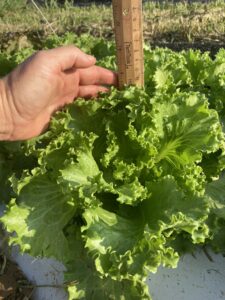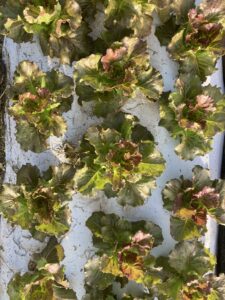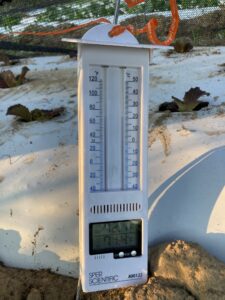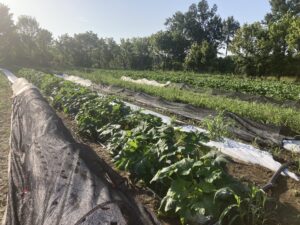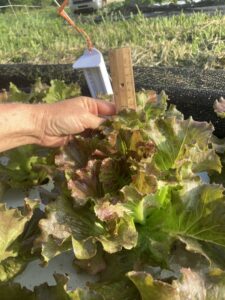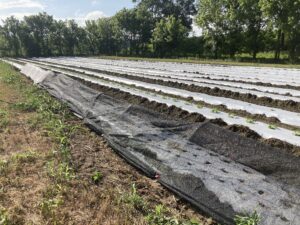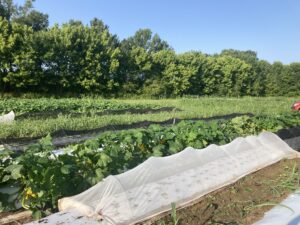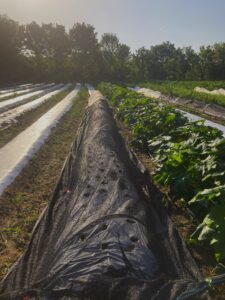Progress report for FS24-362
Project Information
I am interested in exploring the possibility of extending certain cool season crops into summer by utilizing shade cloths and selecting for heat-tolerant varieties. The study I am proposing would combine both of these specifically in regard to head lettuce. There are more variables to be explored in the future, such as overhead watering and misting systems, different types of mulching, and other crops and varieties (kales and cilantro). While researching squash bugs on our farm, an entomologist and my partner noticed that the squash underneath the Proteknet was growing at a much faster rate than the squash outside of the netting. This could be due to it aiding in respiration and cycling of CO2. If the lettuce grows more quickly under the netting, it could then produce a marketable head more quickly, avoiding some of the adverse effects of warmer temperatures. As a farmer of twenty years myself, I would calculate costs and consider the lowest cost and still most effective means of achieving the results I aspire towards.
In order to learn whether shade cloth can extend the season for lettuce growth from late-June through mid-September in Alabama, a 50-foot bed will be planted every two weeks and covered with a 50% shade cloth. The cloth will hover above the crops, resting on hoops set out every 5 feet. Another 50-foot section of each bed will be planted at the same time but instead have the hoops and Proteknet covering it. A 5-foot space in between the two will be planted, but left uncovered as a control. Because we know from experience that lettuce will not grow well in the southern summer heat without some form of aid, any more than a small control space would be a waste of resources. Beds would be planted at two-week intervals from June 1st through July 15th and then repeated on three other beds beginning August 1st. Three heat-tolerant varieties of lettuce will be trialed; ‘Bergam’s Green’ (green leaf), ‘Cherokee’ (red summer crisp), and ‘Lovelock’ (multicolored). 2- 128 plug flats will be seeded every two weeks beginning on May 1st. Each flat will have equal number of the three varietals. One month after seeding, one flat will be transplanted and covered with shade, while the other is transplanted and covered with Proteknet. Succession planting will continue every two weeks for 12 weeks, creating 6 successions, as the temperatures increase. In order to increase chances of success, all transplants will be planted into pre-irrigated soil in three rows with plants 12 inches apart within the rows. The beds will be covered with white plastic mulch in order to lessen weed pressure. Measurements will be taken weekly. The measurements taken will be of the temperature both beneath each shade cloth and beneath each insect barrier, as well as temperature with no cover. Plant growth will also be measured and charted weekly. Observations of physical characteristics such as yellowing of leaves, tip burn, and tendency to bolt will be noted weekly as well. When lettuces are ready to harvest, they will be both counted (heads) and weighed. Marketable, as well as notably unmarketable, data will be collected.
Cooperators
Research
A total of five plots of lettuce were planted in two-week successions beginning with greenhouse seeding on May 1st. Each planting consisted of a minimum of three heat-tolerant cultivars of lettuce and a maximum of four. Cultivars trialed were ‘Cherokee’ (Johnny’s Seeds), ‘Lovelock’ (High Mowing Seeds), ‘Conversion’ (Seedway), and Bergam’s Green (Johnny’s Seeds). Seeds were sown into 128-cell seed flats with Pro-Mix soil medium amended with 0.4% of each blood meal and bone meal. Seed flats were maintained in a greenhouse for three weeks before transplanting seedlings.
The soil transplanted into is an alluvial, silty loam which was pasture for many years. Beds were prepared in a standard method of tillage. Nature Safe (8-6-6) granulated turkey litter fertilizer was applied at a rate of 16 pounds per 100-foot bed. The beds were covered in standard white plastic mulch with a single buried drip line with 8-inch emitters.
Each three-week interval, half of the transplants were planted under 50% shade cloth and half were planted under Proteknet insect netting, with a few plants of each cultivar left uncovered as a control.
Thermometers were placed under each shade cloth and netting and outside of any covering to record both the high and low temperatures. These were noted weekly.
Each week, growth measurements were taken using a standard ruler and photographed. Toward the end of the experiment, germination data from the greenhouse was collected, as well as losses in the field after transplanting.
A review of non-destructive methods for measuring Leaf Area Index (LAI) is ongoing (Fang et. al., 2019 and Breda, 2003) and will be implemented in year two. Suggestions for other parameters to measure, which are non-destructive and do not require cost-prohibitive equipment, are welcome. Both the number of heads harvested and the weight were recorded separately for each variety and under each treatment. The total weight was divided by the number of heads harvested.
Data was recorded and processed in Microsoft Office Excel 2007.
Summer Lettuce Production in the Southeast- Margaret Ann Snow
Leaves under the 50% shade cloth grew larger than those under the Proteknet. Under the Proteknet, heads of lettuce grew denser but leaves were shorter and tougher. This could be because the lettuce under the shade was creating more area for gathering sunlight.
Using tools to measure Leaf Area Index would provide more precise data, as well as measuring plant spread and counting the number of mature leaves (Sandmann et al, 2013). Under low solar radiation plants can increase height, yet decrease biomass (Kavga et al, 2018). This accounts for the larger growth under shade cloth yet the lower average weight per head as compared to the harvest from under the Proteknet (Fig. 2 and Fig. 3).
In Plot 1, under shade, ‘Cherokee’ and ‘Bergam’s Green’ began to ‘bolt’ at 58 days from greenhouse seeding. ‘Bolting’ is the process of rapid stem elongation prompted by the shoot apical meristem (SAM) and marks the transition from vegetative to reproductive growth (Chen et al, 2018). Allowing a head of lettuce to develop and grow into the largest head and greatest weight possible before the process of bolting begins is desirable. The ideal number of days until harvest varies with cultivar, treatment, and external conditions due to weather. Harvest dates were adjusted in response to signs of bolting.
Week one harvest is larger possibly because the temperatures were lower overall then and increased as summer progressed. Thermometers recorded the highest high and lowest low. There was not a noticeable variability in the lows, except for an unexplained spike in outdoor low one week, as seen in Figure 4. However, there is great variability in the high temperature recordings shown in Figure 5. The shade cloth remained close to the control except for an unexplainable spike on June 26th. The Proteknet was noticeably warmer.
The ‘Bergam’s Green’ seed had difficulty germinating. The seed company was contacted and replacement seed sent, which also did not germinate well. Beginning June 25th, all seed flats were placed in a cool room kept at 60 degrees Fahrenheit for two days to address lettuce seed’s thermal sensitivity. There were also losses in the greenhouse due to bird activity, ant activity, and excessive rain, which was addressed by placing some of the Proteknet over the seed flats and moving them in and out of the greenhouse covering.
In Plot 3, the southern most of the three rows under Proteknet was almost a complete loss. This is likely due to the single irrigation line being too far from this row. It was not the case under the shade cloth in the same bed.
In year two, some of the challenges presented in the greenhouse will be addressed and a more reliable process solidified to ensure a higher percentage of plants produced to be transplanted. These practices will include double-seeding the seed flats, placing them into a 60-degree room for 72 hours, and keeping them covered with the Proteknet to deter birds and ants while growing in the greenhouse.
Two irrigation lines will be laid for each bed to ensure adequate water for each plant. Ideally, overhead irrigation would be applied daily in the afternoon, but the system in place for this study would now allow it this year.
There was minimal worm damage, which could be addressed with a weekly spraying of Bacillus thuringensis, but financial analysis would need to be done to determine whether or not it would be worth the expense. The losses from this pest damage were minimal.
It would benefit farmers to know if taking the shade cloth for the final week of growth prior to harvest would be beneficial. It would also be beneficial to conduct a study of summer lettuce production under differing percentages of shade values, such as 40%. In year two of the study, a 40% shade cloth will be included.
Market research into whether the lighter, but larger heads from under the shade cloth or the smaller, yet denser heads from under the Proteknet are preferable to consumers would be valuable information for farmers. Much wholesale lettuce is sold by weight, but there are also sometimes size requirements. Lettuce directly marketed to consumers is often sold by the head.
Studies on heat-tolerant lettuce varieties conducted in New Mexico suggest two varieties of romaine lettuce, ‘Sparx’ (Johnny’s Seeds) and ‘Parris Island Cos’ (Baker Creek Heirloom Seed Co.) could have potential to surpass the varieties trialed here (Joukhadar et al, 2023). These varieties will be included in the second year of trials.
Sesquiterpene lactone is a specialized plant metabolite, which causes a bitter flavor when lettuce is damaged or grown in high temperatures. This will be further researched in the second year, along with testing lettuce cultivar brix levels with a refractometer.
Methods for collecting and analyzing data will be adjusted in year two. The data initially desired will continue to be measured and new data recorded in addition. This new data will include germination rates, losses in the field, leaf area index, differing percentages of shade cloth, and brix. A big improvement in this research would be in the area of data analytics through the utilization of software and statistical analytics.
Educational & Outreach Activities
Participation summary:
I presented the research on summer lettuce production at the SOWTH conference hosted by Georgia Organics in early February of 2025. I included a form for attendees to sign up for more information on the field day I will host this summer. I will be on a panel for the 133rd Farmer's Conference in Montgomery, Alabama on March 20th. Most of the outreach was planned for year two, once I have a better idea of what the results were.
